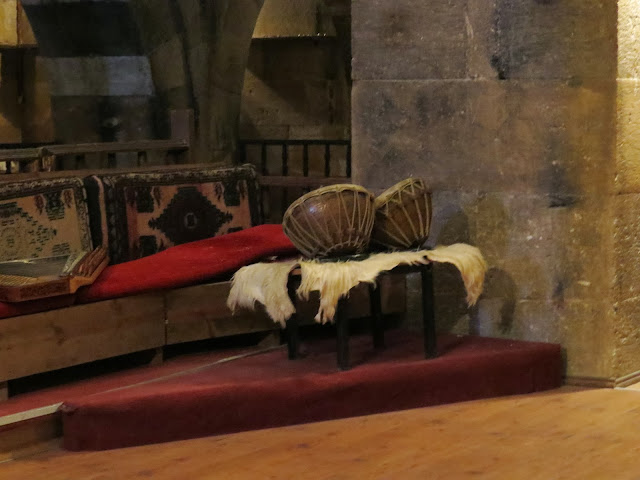The final stop on Day 1 was a caravanserai for an evening presentation
by whirling dervishes. But before that, Yesim
took us through another valley of fairy chimneys in the late afternoon
sunlight. No matter how many you see,
whether looking at one or a group, they are all different, and every one fascinating, from every angle, in every light.
This one has a rather x-rated name, but I thought it looked like a snail.
Now off to the caravansary.
Our written guide book calls a caravanserai a motel for
camel trains on the Silk Road. They were
large fortress-like compounds where people and their animals could stay for the
night. The sultans, being no fools,
provided the caravansaries no more than one day’s ride apart, including food
and water, places to keep animals and trade goods, and even veterinary care.
Before the establishment of modern Turkey, dervishes were
regional or local groups of religious practitioners with carrying degrees of
power. There was no single leader or
hierarchy of leaders as in Christian churches.
As a result, Ataturk believed that decentralized power would plague his
modern state, so the dervishes were outlawed.
Instead, the groups of dervishes established foundations for
social purposes. They continue their
spiritual practice, but use their communities to provide social services to
their neighbors. The group that we saw
was not paid for the program, but our entry fees went to their foundation to be
handed off to the poor, or schools or hospitals, as they chose.
The whirling dervishes use their motion to enter a spiritual
state. One hand is listed toward the
sky, the other toward earth, to join the two.
The practice goes through seven stages, each one honoring a different
aspect of their beliefs. The practice
was developed by the poet and philosopher Rumi, whose burial site we will visit
in Konya. Ordinarily photos are not
permitted, but since the group did not have prepared photos for us, they
returned to the stage area after their practice was completed for a few minutes
so that we could take photos of our own.
The man in black is something of a leader, who moves slowly thorough the group as a focal point, so they know when to change places.






























No comments:
Post a Comment